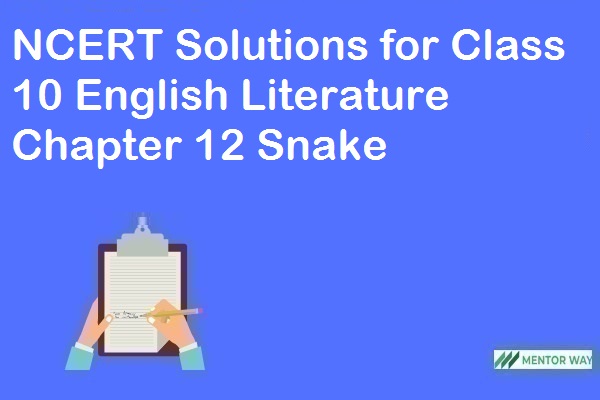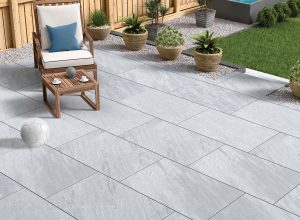NCERT Solutions for Class 10 English Literature Chapter 12 Snake
12 min read
NCERT Solutions for Class 10 English Literature Chapter 12 Snake
NCERT Solutions for Class 10 English Literature Chapter 12 Snake are part of NCERT Solutions for Class 10 English. Here we have given NCERT Solutions for Class 10 English Literature Chapter 12 Snake.
You can download the NCERT Solutions for Class 10 English Chapter 12 Snake in PDF Below. Prescribed textbook by CBSE for Chapter 12 Snake is a standard X NCERT course book for English.
| Board | CBSE |
| Textbook | NCERT |
| Class | Class 10 |
| Subject | English Literature |
| Chapter | Chapter 12 |
| Chapter Name | Snake |
| Category | NCERT Solutions |
NCERT Solutions for Class 10 English Literature Chapter 12 Snake
TEXTUAL EXERCISES
(Pages 124, 127)
Question 1.
Snakes generate both horror and fascination. Do you agree? Why? Why not?
Answer:
I agree with the statement that snakes generate both unmentionable horror and fascination for the first time. They generate horror (of death) because they are poisonous. A single bite could result in a painful death.
They cause fascination because they are lovely to look at because of the colors and designs on their bodies. The design of a paw on the hood of cobra adds beauty to it. The patterned circles, squares, or chequered designs add beauty to pythons. In fact, all species I have beautiful patterns on their bodies. But they cause a sense of revulsion and fear at their vileness in our hearts.
Question 2.
Read what W.W.E. Ross feels when he sees a snake and fills in the table given below :
The Snake Trying
The snake trying
to escape the pursuing stick,
with sudden curvings of thin
long body. How beautiful
and graceful are his shapes!
He glides through the water away
from the stroke. O let him go
over the water
into the reeds to hide
without hurt. Small and green
he is harmless even to children.
Along the sand
he lay until observed
and chased away, and now
he vanishes in the ripples
among the green slim reeds.
| What is the snake doing? | Words to describe the snake | Poet’s plea |
| (a) | (b) | (c) |
Answer:
(а) The snake is trying to escape the sticks of the onlookers. It glides through the water to escape these.
(b) Curvings of a thin long body, beautiful, graceful are his shapes, glides through, small and green, vanishes in the ripples among the green slim reeds.
(c) The poet’s plea is not to kill the snake because it is a beautiful and graceful creature. It is harmless to all. So it is not good to kill it.
Question 3.
Given below is the summary of the poem Snake in short paragraphs. However, they are jumbled. Work in pairs and put the summary into a logical sequence.
(a) After drinking water to satisfaction, the snake raised his head dreamily and flickered his forked tongue and licked his lips. The snake looked around like a God and then slowly proceeded to curve round and move away from the water trough.
(b) The poet felt much like the ancient mariner who had killed the albatross for no reason. He wishes that the snake would come back. He thinks of the snake as a king in exile who has to be crowned again. He also regrets having missed his opportunity of knowing and understanding one of the lords of life.
(c) As the snake put his head into the hole to retreat into the earth, the poet was filled with a protest against the idea of the snake withdrawing into his hole. The poet put down his pitcher, picked up a log, and hurled it at the snake. The snake twisted violently and with great alacrity vanished into the hole in the wall.
(d) A snake visited the poet’s water trough on a hot afternoon to quench his thirst. The poet who had also gone to the trough to fill water in a pitcher waited for the snake since he had come at the trough prior to the poet.
(e) The voices of education inside the poet tell him that it was the fear for the snake that made him refrain from killing him. However, the poet feels that though he was quite afraid of the snake, he did actually feel honored that a snake had come to seek his hospitality from the deep recesses of the earth.
(f) He is guilt-ridden. He feels that he has to atone for the meanness of his action of throwing a log at the snake.
(g) The snake rested his throat upon the stone bottom and sipped the water into his slack long body. After drinking water, he raised his head just like cattle do and flashed his forked tongue, thought for a moment, and then bent down to drink some more water.
(h) Education and social conventions make the poet think that the golden brown poisonous snake must be killed and that as a brave man he must undertake the task of killing the snake.
(i) The poet instantly felt sorry for his unrefined and contemptible act and cursed the voices of education and civilization that had shaped his thought processes and urged him to kill the snake.
(j) However, the poet instinctively likes the snake, treats him like a guest, and feels honored that it had come to drink at his water trough. The poet questions himself and wonders whether his not daring to kill the snake proved that he was a coward and whether his desire to talk to the snake reflected his perversity.
Answer:
The logical sequence will be :
(d) →
(g) →
(a) →
(h) →
(e) →
(j) →
(c) →
(f) →
(i) →
(b) →
Question 4.
Based on your reading of the poem, answer the following questions by ticking the correct options:
1. ‘he lifted his head from his drinking as cattle do’—The poet wants to convey that the snake
(a) is domesticated
(b) is innocent
(c) is as harmless as cattle
(d) drinks water just like cattle
2. ‘Sicilian July’, ‘Etna smoking’ and ‘burning bowels of the earth’ are images that convey that
(a) there are snakes in volcanic areas
(b) the poet lived in a hot area
(c) it was a really hot day when the snake came
(d) Sicilian snakes are dangerous
3. ‘A sort of horror, a sort of protest overcame me’—The poet is filled with protest because
(a) he doesn’t want to let the snake remain alive
(b) he fears the snake
(c) he doesn’t want the snake to recede into darkness
(d) he wants to kill it so that it doesn’t return
4. In the line ‘And as he slowly drew up, snake-easing his shoulders, and entered farther the phrase ‘snake-easing his shoulders’ means
(a) loosening its shoulders
(b) slipping in with majestic grace
(c) moving slowly
(d) moving fast
5. ‘He seemed to me like a king in exile …’ The poet refers to the snake as such to emphasize that the snake
(а) is like a king enduring banishment
(b) is like a king due to be crowned
(c) is a majestic king who came for a while on earth
(d) is a majestic creature forced to go into exile by man
6. ‘I thought how paltry, how vulgar, what a mean act’— The poet is referring to
(а) the snake going into the dreadful hole
(b) the accursed modern education
(c) the act of throwing a log of wood at the snake
(d) the act of killing the snake
Answer:
- → (d) drinks water just like cattle
- → (c) it was a really hot day when the snake came
- → (c) he doesn’t want the snake to recede into darkness
- → (b) slipping in with majestic grace
- → (d) is a majestic creature forced to go into exile by man
- → (c) the act of throwing a log of wood at the snake
Question 5.
Answer the following questions briefly :
(a) Why does the poet decide to stand and wait until the snake has finished drinking? What does this tell you about the poet? (Notice that he uses ‘someone’ instead of ‘something’ for the snake.) (V. Imp.)
(b) In stanza 2 and 3, the poet gives a vivid description of the snake by using suggestive expressions. What picture of the snake do you form on the basis of this description ?
(c) How does the poet describe the day and the atmosphere when he saw the snake ? (CBSE 2012) (V. Imp.)
(d) What does the poet want to convey by saying that the snake emerges from the ‘burning bowels of the earth’ ?
(e) Do you think the snake was conscious of the poet’s presence ? How do you know ?
(f) How do we know that the snake’s thirst was satiated ? Pick out the expressions that convey this.
(g) The poet has a dual attitude towards the snake. Why does he experience conflicting emotions on seeing the snake ? (V. Imp.) (CBSE 2016)
(h) The poet is filled with horror and protest when the snake prepares to retreat and bury itself in the “horrid black’, ‘dreadful’ hole. In the light of this statement, bring out the irony of his act of throwing a log at the snake. (V. Imp.)
(i) The poet seems to be full of admiration and respect for the snake. He almost regards him like a majestic god. Pick out at least four expressions from the poem that reflect these emotions.
(j) What is the difference between the snake’s movement at the beginning of the poem and later when the poet strikes it with a log of wood ? You may use relevant vocabulary from the poem to highlight the difference.
(k) The poet experiences feelings of self-derision, guilt and regret after hitting the snake. Pick out expressions that suggest this. Why does he feel like this ?
(l) You have already read Coleridge’s poem The Ancient Mariner in which an albatross is killed by the mariner. Why does the poet make an allusion to the albatross ?
(m) T have something to expiate’-Explain. (V. Imp.)
Answer:
(a) The poet decides to stand and wait till the snake has finished drinking because he looks at it as a guest. Secondly, the poet came there after the snake had come. So he must wait on that count. This shows that the poet is understanding, civilized and well-mannered.
(b) From the suggestive expressions in stanzas 2 and 3, the picture emerges very beautiful and clear. The poet is in pyjamas and has his pitcher. The snake has trailed its yellow-brown slack body over the edge of the trough. Resting its throat it is sipping water softly and silently.
(c) The poet describes the day and atmosphere hot. It is clear in the usage of words and phrases like : ‘On a hot, hot day’, ‘in the deep, strange scented shade …’, ‘burning bowels of the earth’, ‘day of Sicilian July, when Etna smoking’.
(d) By this the poet wants to convey that there is intense heat inside the hole of the earth as it is burning.
(e) I think the snake was not conscious of the poet’s presence. If it was, it couldn’t have behaved majestically and as if it were in a dream. It looked around like a god but not at the poet, though it looked in the direction where the poet stood.
(f) The snake’s thirst was satiated as it looked dreamily after drinking the water. The expressions are : ‘And flickered his two-forked tongue’, ‘mused a moment’, ‘He drank enough’, ‘And lifted his head, dreamily’.
(g) The poet has a dual attitude towards the snake. It is because he is governed by human instinct and rational thought (called voice of human education). One, natural human instinct makes him appreciate the snake and love animals. Second, the rational thought says that snakes are poisonous. So they must be killed.
(h) The irony is that the snake itself is withdrawing. It means there is no need of the poet’s throwing a log on the snake. But he does it which is later regretted by him.
(i) The expressions are : ‘And flickered his two-forked tongue/from his lips’, ‘and mused a moment’, ‘But must I confess I liked him’, ‘How glad I was …’, ‘like a guest in quiet’, ‘I stared with fascination’, ‘Like a king in exile’.
(j) At the beginning the snake is thirsty. It draws its slack body over the edge of the water-trough leisurely and slowly. But when the poet strikes a log at it, it ‘convulses and writhes’ like lightning.
(k) The expressions are : ‘A sort of horror, a sort of protest’, ‘I thought how paltry, how vulgar, what a mean act!’, ‘I despised myself, ‘to expiate’, ‘A Pettiness’.
(l) The poet makes an allusion to the albatross because no one wanted that the albatross should be killed by the Ancient Mariner. However, later it was called a right thing.
The mariners wanted it to come to them as it had brought wind to steer the ship clear from the ice. Like this, the poet in ‘Snake’ wants the snake back to accept his hospitality like an honoured guest.
(m) It means that the poet has something to regret for ever. This is that he shouldn’t ; have thrown a log to kill the snake.
Question 6.
The encounter with the snake and the dual response of the poet to his presence at the water trough reflect a conflict between civilized social education and natural human instincts. The poet writes a diary entry highlighting how he was torn between the two voices. Write his diary.
Answer:
Monday, 18th July, 20 – 9 pm
I can’t forget the hot day when I saw an earth-brown snake come to my water trough to drink water. It trailed its yellow-brown slack and soft body over the edge of the stone trough. Then it drank water like the cattle do. It looked majestically all around like a god. It flickered its two-forked tongue and mused for a moment. Instinctively, I felt I charmed by it.
But the voice of civilised social education made me feel that such snakes are poisonous and they must be killed. So I threw a log at the snake. The snake had by then proceeded to enter the hole. The remaining part of its body convulsed and writhed like lightning at the noise at my doing so. In a moment, the snake was gone. But after this act, I felt a sense of guilt. A deep conflict rose between my natural human instincts and civilized social education. I wondered what was this all; cowardice, perversity, wish to talk to the snake or humility ? Then I felt it very bad that I should have intended to kill the snake. It was an honoured guest and an uncrowned king living into the bowels of the earth. It had accepted my hospitality. So as a host I must not have thrown the log at it. But I did and I shall regret it throughout my life !
D.H. Lawrence
Question 7.
Alliteration is the repetition of sounds in words, usually the first sound. Sibilance is
………………………………………………………………………………………………………………………………
To what effect has the poet used these devices ? How has it added to your understanding of the subject of the poem ? You may record your understanding of snake characteristics under the following headings :
(a) Sound
(b) Movement
(c) Shape
Answer:
By using alliteration, sibilance and onomatopoeia D. H. Lawrence has succeeded in creating a kind of visual and sensory effect on us. In line ‘And trailed his yellow-brown slackness soft-bellied down’, we feel the onomatopoeiac effect in ‘trailed’, ‘slackness’, and ‘soft-bellied down’. We almost hear both the sound and the movement of the snake. Equally in line ‘And flickered his two-forked tongue’, |f| sound (sibilance) and onomatopoeiac effect in ‘flickered’ lend a visual and sensory movement to the snake.
In line ‘Softly drank through his straight gums, into his slack long body/Silently’, the |s| sound conveys the snake’s feature of its long body. Obviously, these lines give out the effect of the physical feature of the snake through sibilance. In doing so, the poet has succeeded in making us understand the snake through the sound, movement a d shape. Another example of onomatopoeic word ‘slowly’ and |s| sound indicating the use of sibilance, conveys this effect: ‘And slowly turned his head,/And slowly, very slowly, as if thrice a dream’.
Question 8.
The poet has also used both repetition and similes in the poem. For example—‘must wait, must stand and wait’ (repetition) and ‘looked at me vaguely as cattle do’ (simile).
Pick out examples of both and make a list of them in your notebooks. Give reasons why the poet uses these literary devices.
Answer:
The following are the lines chosen from the poem showing repetition of sounds :
Alliteration
” alt=”” aria-hidden=”true” />

Similes
- as drinking/cattle do
- And lifted his head, dreamily, as one who has drunken.
- And looked around like a god
- And slowly, very slowly, as if thrice a dream.
Note : Students themselves can find out more similes by seeing comparison between two things where as or like have been used.
Question 9.
A calligram is a poem, phrase, or word in which the handwriting is arranged in a way that creates a visual image. The image created by the words expresses visually what the word, or words, say. In a poem, it manifests visually the theme presented by the text of the poem. Read the poem given below. Try to compose a calligram. You could pick a subject of your choice.
Answer:
For self-attempt by students.
We hope the NCERT Solutions for Class 10 English Literature Chapter 12 Snake help you. If you have any query regarding NCERT Solutions for Class 10 English Literature Chapter 12 Snake, Nor the Gilded Monuments, drop a comment below and we will get back to you at the earliest.



